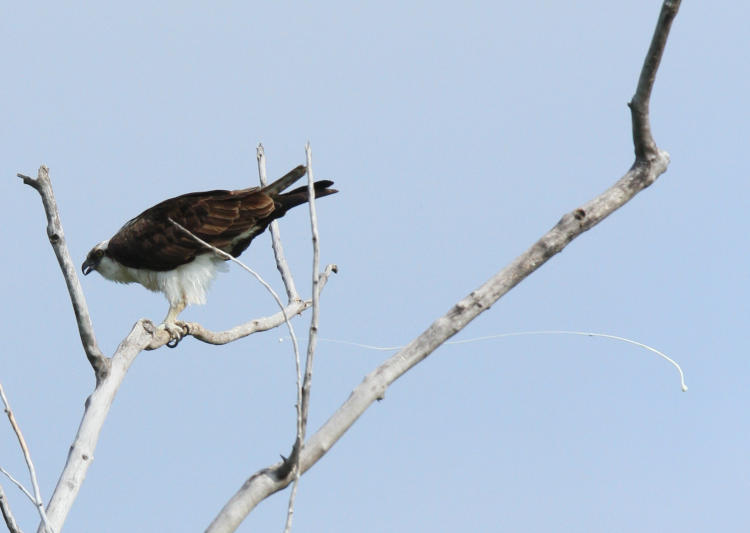Yeah, it’s a terrible movie reference, but you weren’t expecting better anyway so get over it.
The second trip to central New York netted a whole selection of new raptor photos, but unfortunately not as much video as I’d hoped for or intended to get – kinda. I went up there with no particular plans, given that it wasn’t a vacation or shooting trip, but when the opportunities seemed to present themselves and I thought, Hey, this might make a cool video, it didn’t pan out very well (for the raptors, anyway.) There will be some clips in a little bit, but the still photos are plainly better.
First off, the nice views of a juvenile bald eagle (Haliaeetus leucocephalus) from the first trip were a pretty good indication that this one would be better, coming as it did later in the fledging period as the young were hunting on their own. While out early one morning and actually on the phone with a friend (worked best for both of our schedules,) I had to beg off of the call when a pair of juveniles decided to play tag almost directly overhead. Okay then.

Too young to breed and late in the season anyway, plus the fact that there was no aggression being shown, leads me to believe these were siblings just out ‘playing,’ wheeling in big circles in a lazy manner. But they were only two dozen or so meters in the air, so within easy sight – I had to back off the zoom setting to keep them both in the same frame.
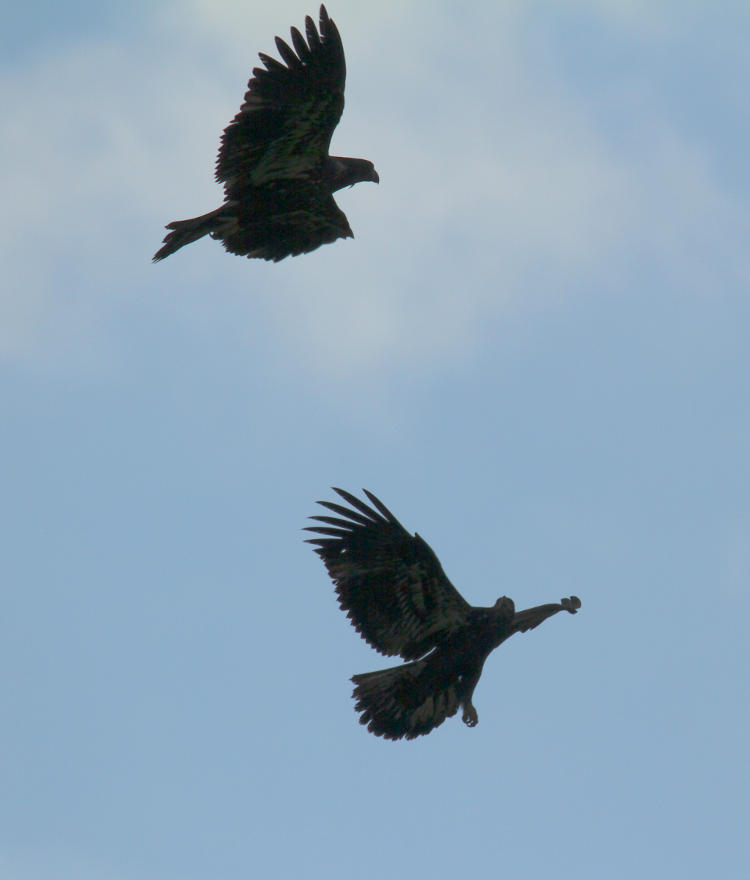
Unfortunately, I somehow missed dialing in exposure compensation for some of these, which kept the sky blue but rendered the eagles as little more than silhouettes, and the early-morning sun was still somewhat behind them from my angle.
But they were being remarkably cooperative, since I have ten consecutive frames with both of them in the photo, completely unprecedented; quite often, even when a pair of birds are flying together, getting them both in the frame requires sharp timing. These guys were my buds.

Now I’ve got the compensation on, so you see what it does to the sky, but at least you can see the eagle – this is at 600mm now. The highlight on the beak indicates that the sun is pretty much due right, not high at all.
Both our bedroom and the foyer windows looked out over not just the cove, but the dead tree on the lakeshore (purposefully retained because it serves so often as a perch,) and thus we could see how often it was occupied. One day, this was by another juvenile eagle, quite possibly one of the same ones as above, given that they were only a few hundred meters away from this spot. Then again, the area is loaded with eagles and it’s an ideal fishing ground, so who knows?
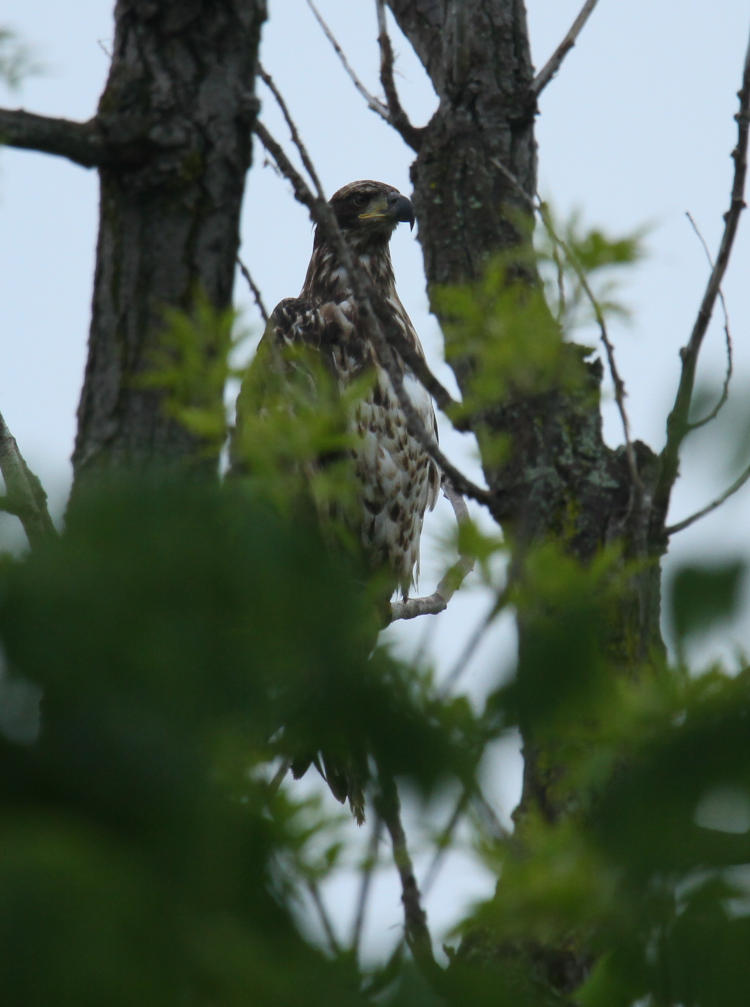
It was raining off and on most of this day, so the raptors were largely remaining perched, and while the eagles normally don’t like close approaches, this one was being patient and I was endeavoring to remain nonthreatening: pausing frequently, gazing all around with a casual air, and otherwise looking like an adolescent boy at the beach trying not to stare. It seemed to work, in that I drew quite close, provoking a little visible discomfort from the eagle and the first indications of wanting to fly off, but it never did.

I suspect the rain had a lot to do with it; it was just too annoying to take flight and chance getting the underfeathers wet too, so the eagle tried to put up with me unless it was absolutely certain that it would have to flee. Given that we left it alone soon afterward, we did our part in conditioning it to tolerating people nearby (The Girlfriend was out there too, but purposefully hanging back to lessen the stress on the bird – she knows.)
The ospreys (Pandion haliaetus) were even more active, and effortless to see much of the time. This is one in the same tree, on a much better day.
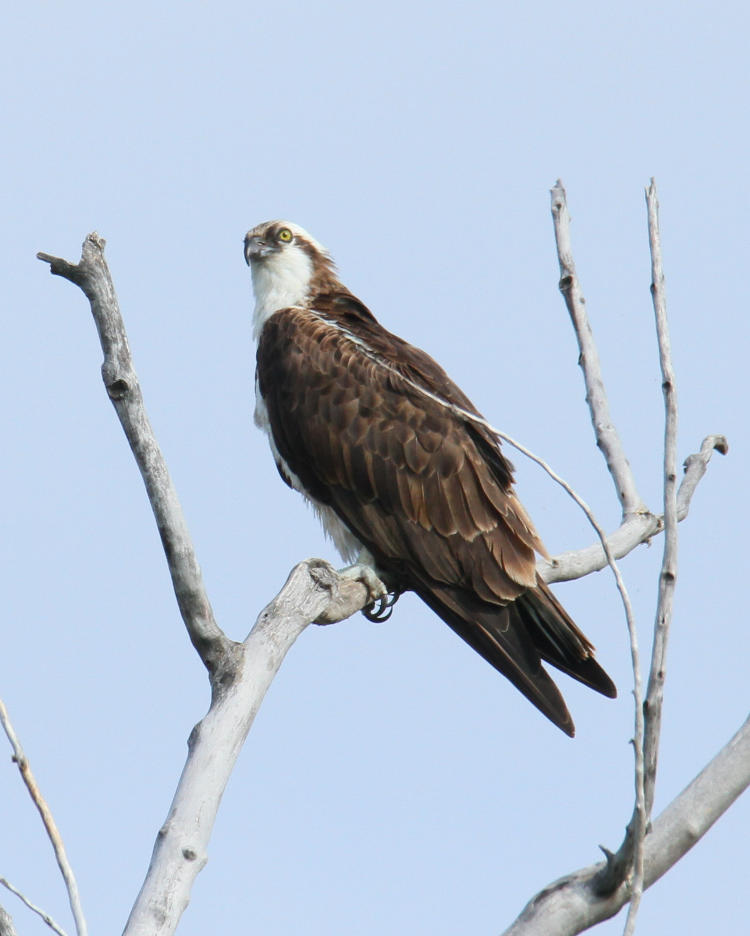
I was purposefully playing with exposure compensation for these shots, to see what rendered better – the goal is to have both the details from the bird and some sky color, and the truth is, without resorting to tricks like ‘high dynamic range’ (which is basically digital compositing,) you’re usually going to take a hit on both to have the best frame. The above is with a full stop over-exposure, but bear in mind, the camera doesn’t know how bright the sky should be and typically sets exposure for a middle level anyway. Thus compensation is not really overexposing by that much, but rendering the light closer to the way it actually was.

This is only 1/3 stop overexposure, probably closest to reality in these conditions – osprey back feathers are pretty deep brown. You can see that the neck feathers are standing up in the stiff breeze off the water, but osprey neck feathers tend not to lie flat very often to begin with – not sure why.
This dead tree sits just off the end of the dock, and on more than one occasion, a perched osprey ignored us as we passed underneath to go out onto the dock, sometimes giving a little territorial cry but otherwise being cool. It was good to see.
Twice, we watched an osprey in territorial dispute with an eagle, which was fascinating.

Osprey on the left, having just blown past the juvie eagle on the right, taking a slash as it did so. Ospreys are smaller and much faster and more maneuverable than eagles, so the eagle was largely relegated to defensive moves, and not much at that, but the osprey also knew, should the eagle actually make purchase with one of those talons, that might be all she wrote. Meanwhile, I was just endeavoring to maintain tight focus and keep them framed during the close passes.

I’m not complaining about this one at all; I consider it enormously lucky to get both in the same frame with such expressive poses. Not to mention that it shows the size disparity more accurately; the previous photo caught the eagle edge-on and minimized its mass a bit. I also can’t vouch for how old the osprey is, but that looks like adult coloration, while the eagle appears to be first year, thus, newly encroaching on the osprey’s territory. This might have been the same eagle as the earlier visit and post, and certainly not any of those shown above, even though it was in the same airspace that the wheeling pair had been.

This is what I typically get when two birds are interacting, with one just out of view, but I can’t deny the expressiveness, and it’s possibly The Girlfriend’s favorite frame.
The eagle, for its part, just wasn’t taking the hint, and the osprey eventually gave up, though the same thing was repeated the next day in nearly the same location. I didn’t have the camera anywhere close by at the time (we were helping with some of the work out at the Gatsby mansion,) and so it was just a viewing experience, but it was easy to see just when the wheeling flight paths of the two birds would intersect, and the osprey definitely made some solid contact. Did it manage to penetrate the eagle’s feathers and do any injuries? I haven’t the faintest, but again, the eagle was unconvinced.
I mentioned earlier my regret in not getting any of the osprey platforms that dotted the roads, perhaps every kilometer or so, but this time around, the young were big enough to be seen easily, and so I corrected my oversight.

We drove past this particular nest constantly, and I thought at one point that we’d missed the young fledging out and leaving the nest, but another day later it was clearly occupied again. That’s one of the adults on the lookout perch, the juvies in the nest, and they deserve a closer look.

Given that these are ‘teenagers,’ I’m attributing those eyes and overall appearance to sneaking out last night to attend a party with friends. But maybe I’m reading too much into it.
[Honestly, the juvies’ eyes are always red, and while it wasn’t terribly cool that morning, it was humid as hell so they were likely trying to dry out. You’ll see more shortly.]
This was one of those ‘planned but missed’ video opportunities. I’d just dropped The Girlfriend off at the airport for her flight home and arrived back at the Gatsby mansion right at sunrise, so despite my lack of sleep, I set out in this ideal light to see if the young wanted to demonstrate any flying practice for their adoring fans. Alas, they were resolutely uncooperative.
Immediately before, on the long driveway from the mansion, I passed another osprey perched directly over the driveway, and stopped for more pics, advancing slowly, while the osprey viewed me with distaste but considered me too minor to worry about.

The reason for this is there, if you look closely: it already has a fish that it’s munching on. Let’s have a slightly better look.
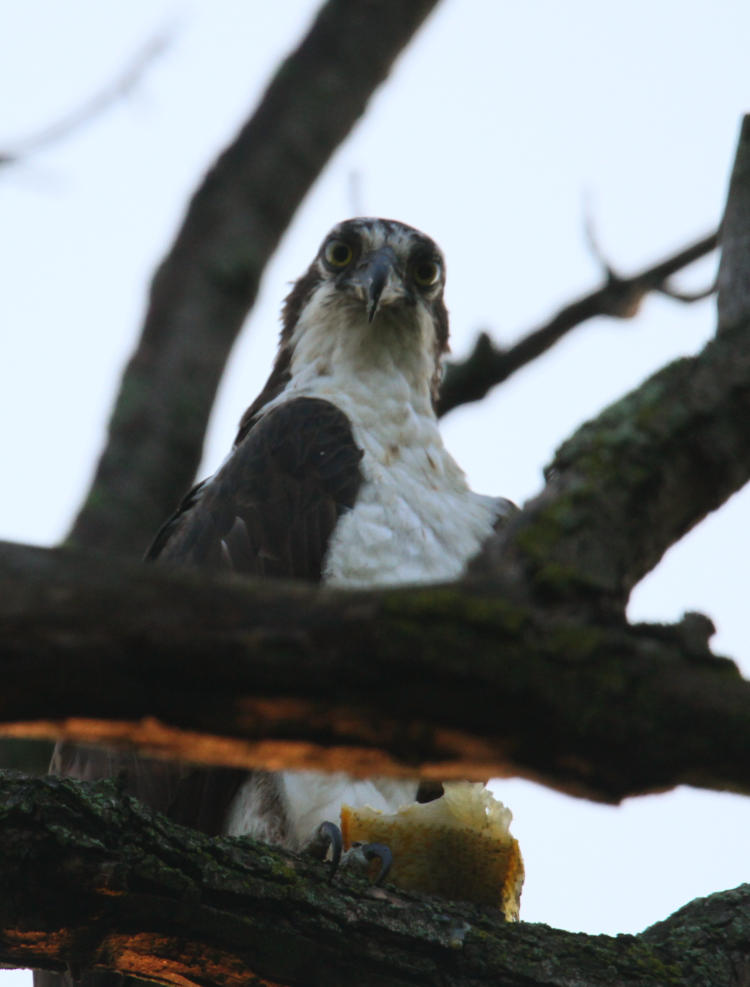
I don’t think I even saw the fish until about this point, and I’m pretty sure that I was shooting through the open sunroof now. But that expression! And the bird never moved, allowing me to do a few frames when I’d passed beyond it and now had the sun at my back, kinda – note the orange light on the tree limbs. Those frames were fine, but nowhere near as good as this shot.
One day while driving on the outskirts of town, I spotted a bird perched on a wire and braked hard, bringing the car to the shoulder, because it looked like a peregrine falcon and I’d never seen one in the area (or indeed, anywhere outside of captivity.) Cornell University, at the opposite end of the lake, has a comprehensive raptor program (potentially the source of the numerous osprey platforms – I never did determine this,) and had one of the first captive breeding programs for peregrines, so seeing one wasn’t out of the question. But no, it was a case of misidentification.
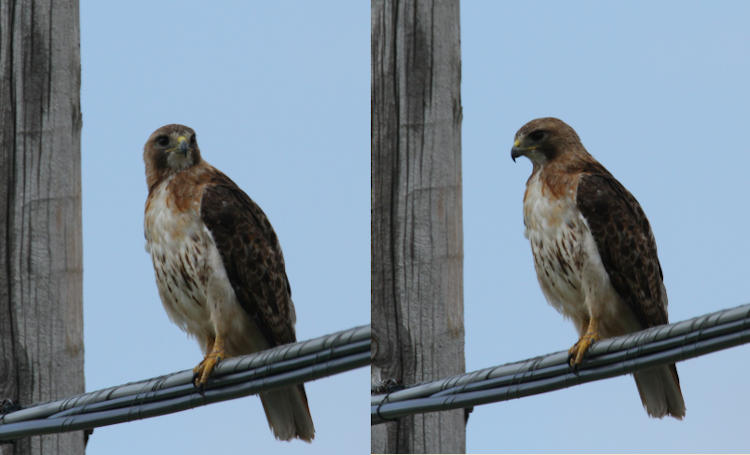
This is merely a red-tailed hawk (Buteo jamaicensis,) very common in the area and exhibiting their typical behavior. But those facial markings aren’t typical, and you can see the ‘mustache marks’ that, driving past at 90 kph, made me suddenly think it was a peregrine. Look at the photos here (which is Cornell’s own site), and you may forgive me. Probably not.
Now let’s get to the video, what there is of it.
Nothing great, but not through lack of trying. For most of these I was even using the tripod, the shotgun mic, and the ‘dead cat’ wind guard – fully prepared. Just, without the cooperation of the subjects.
With the exception of a small handful of photos, I think that covers the main subjects that I wanted to feature from this past trip. So we’ll close with an osprey again, giving its overall opinion of all these damn people on its lake. Ah well.
